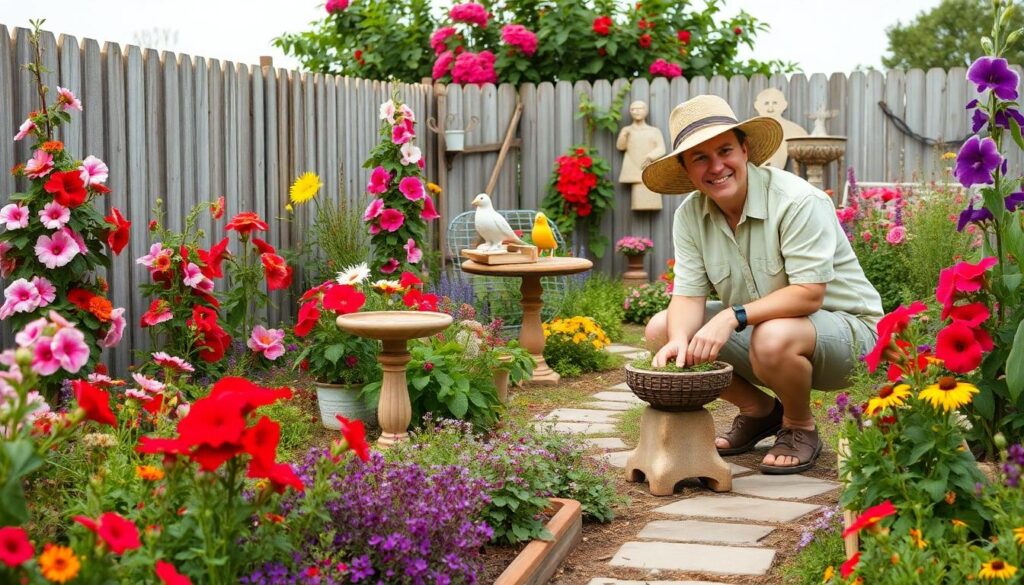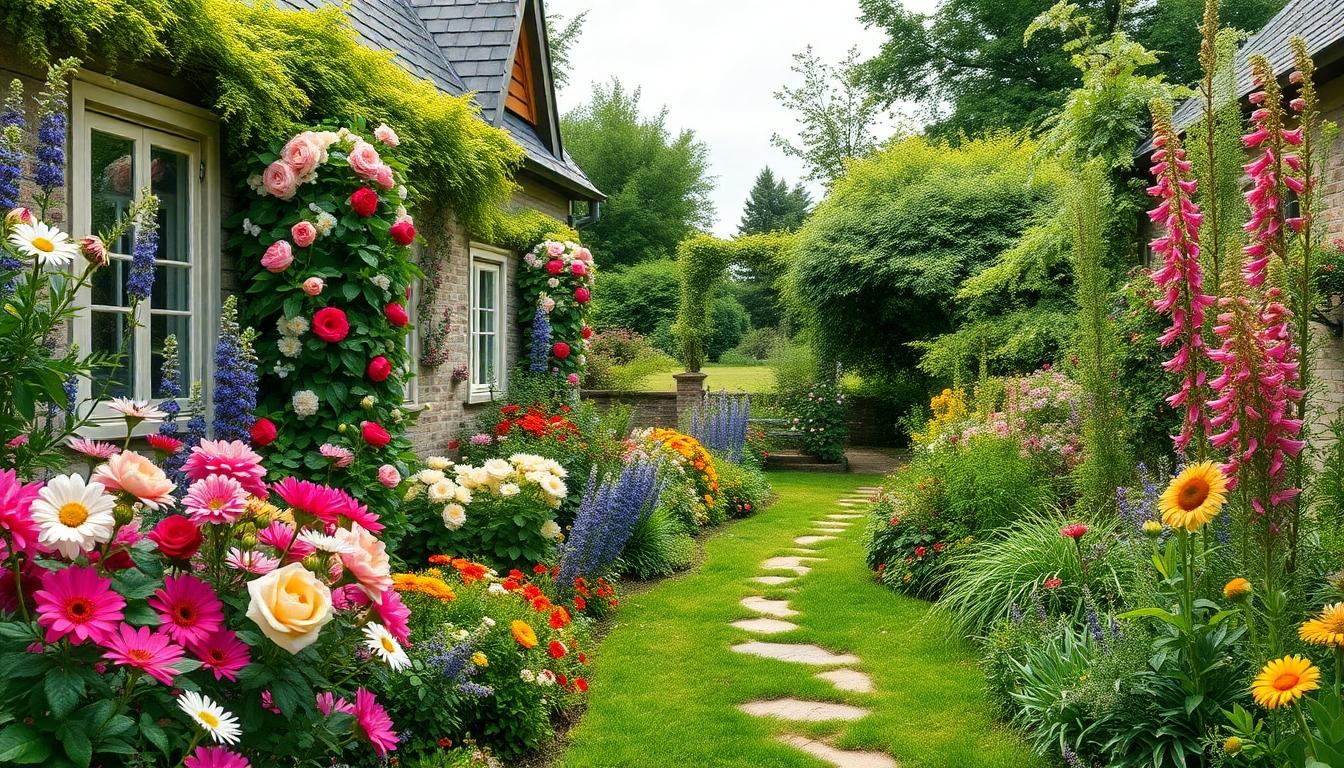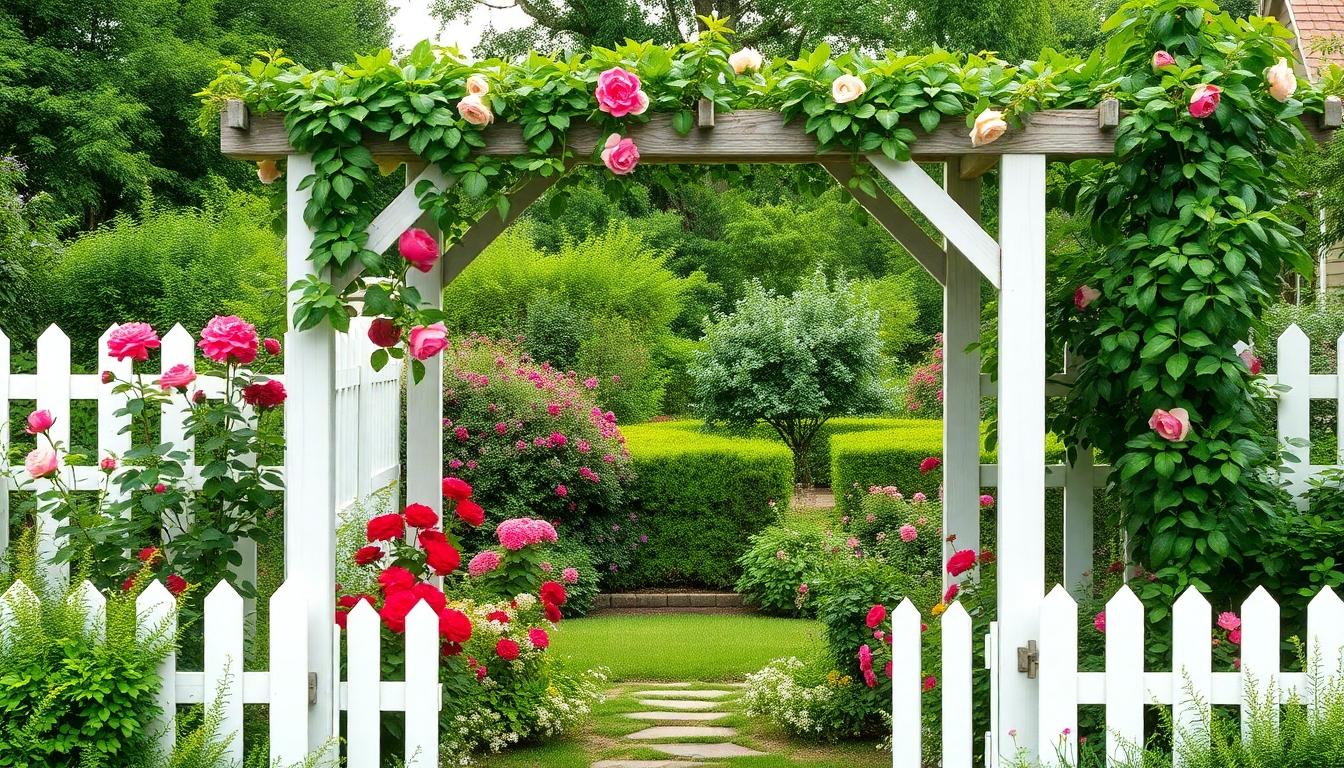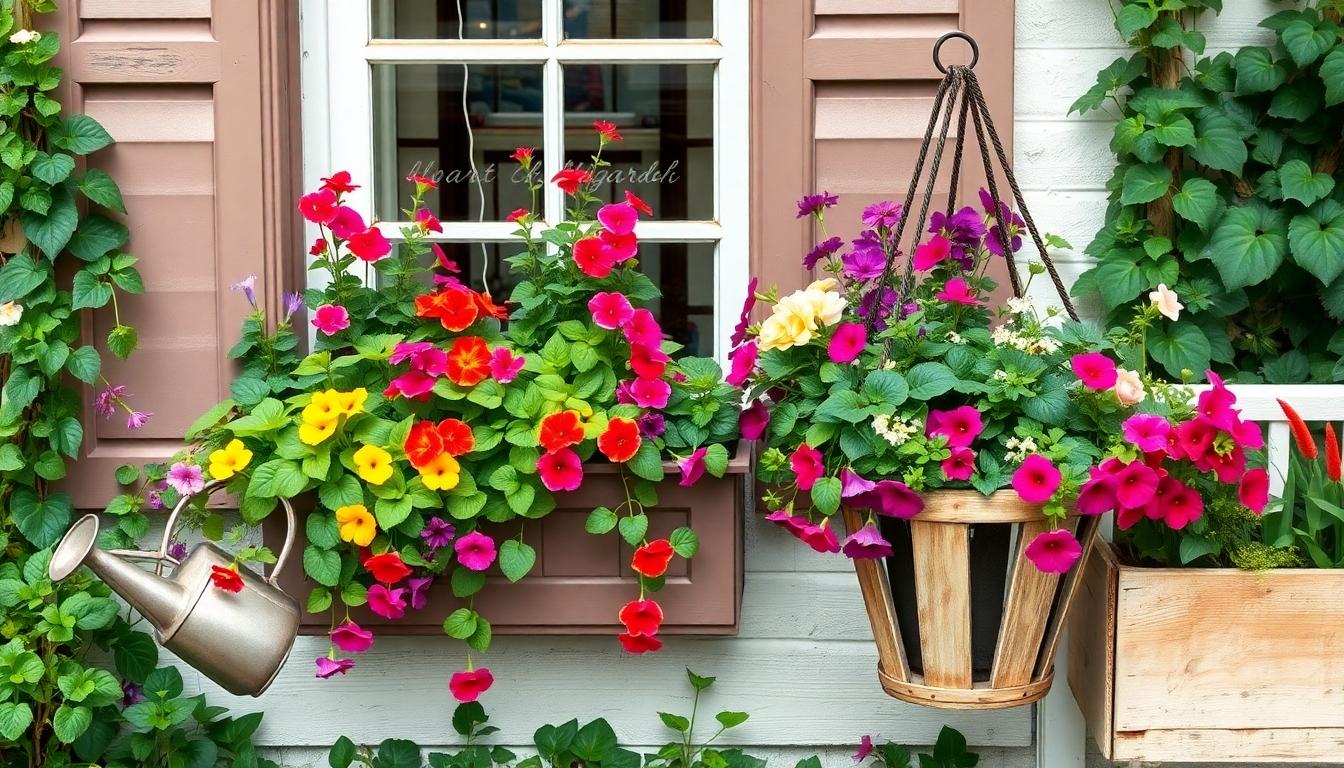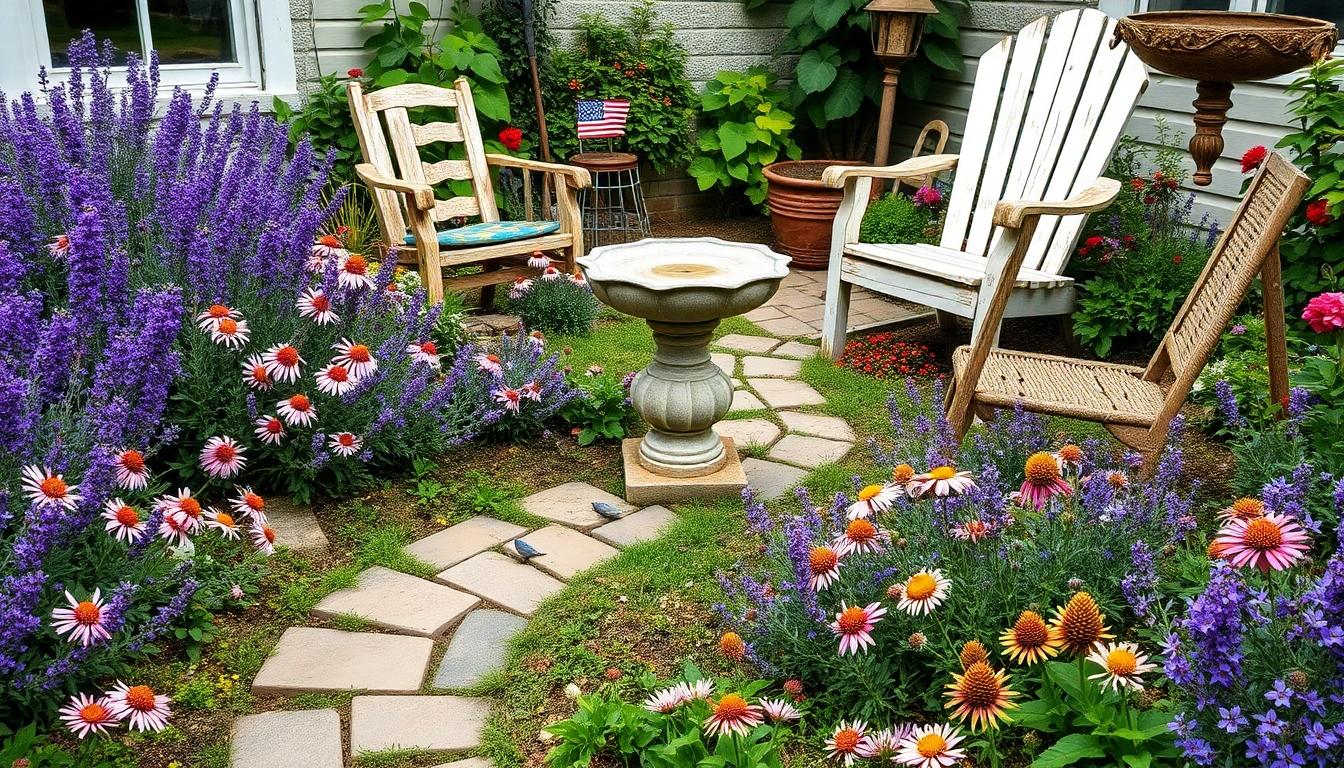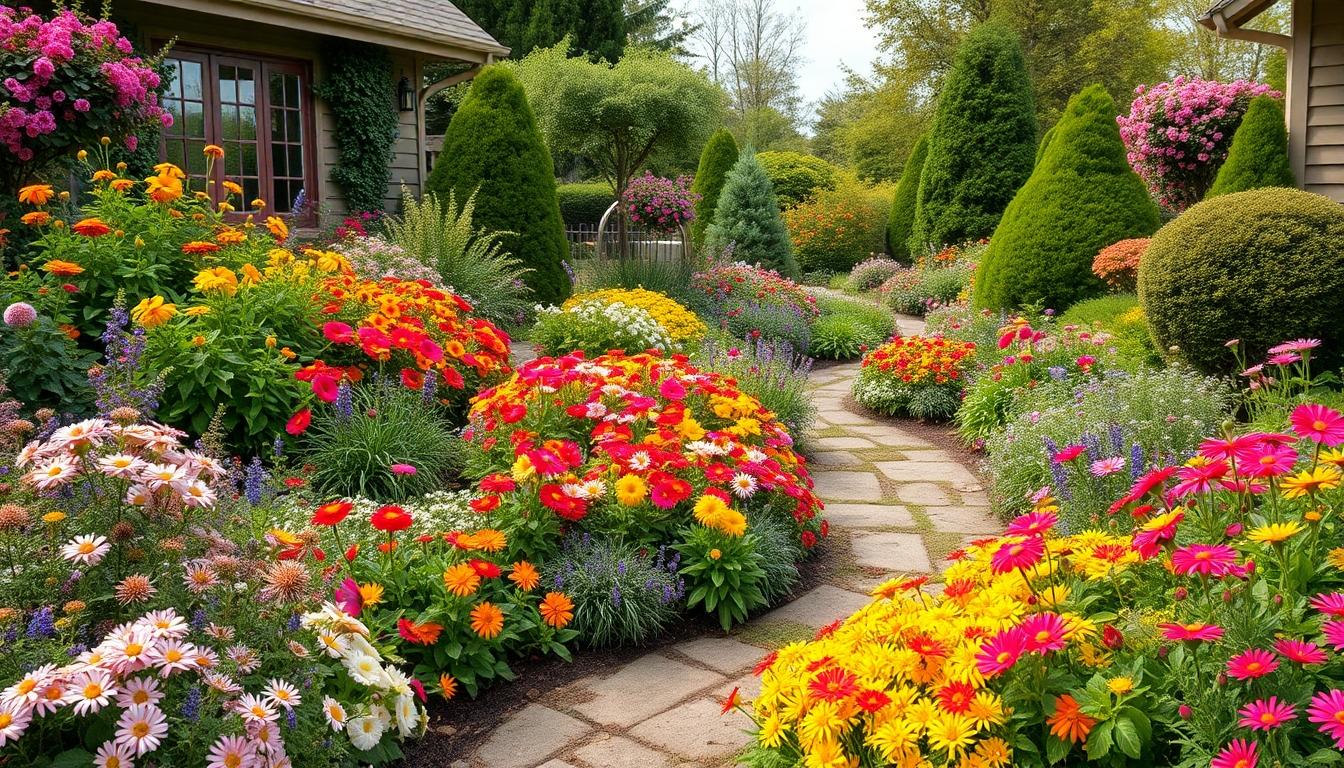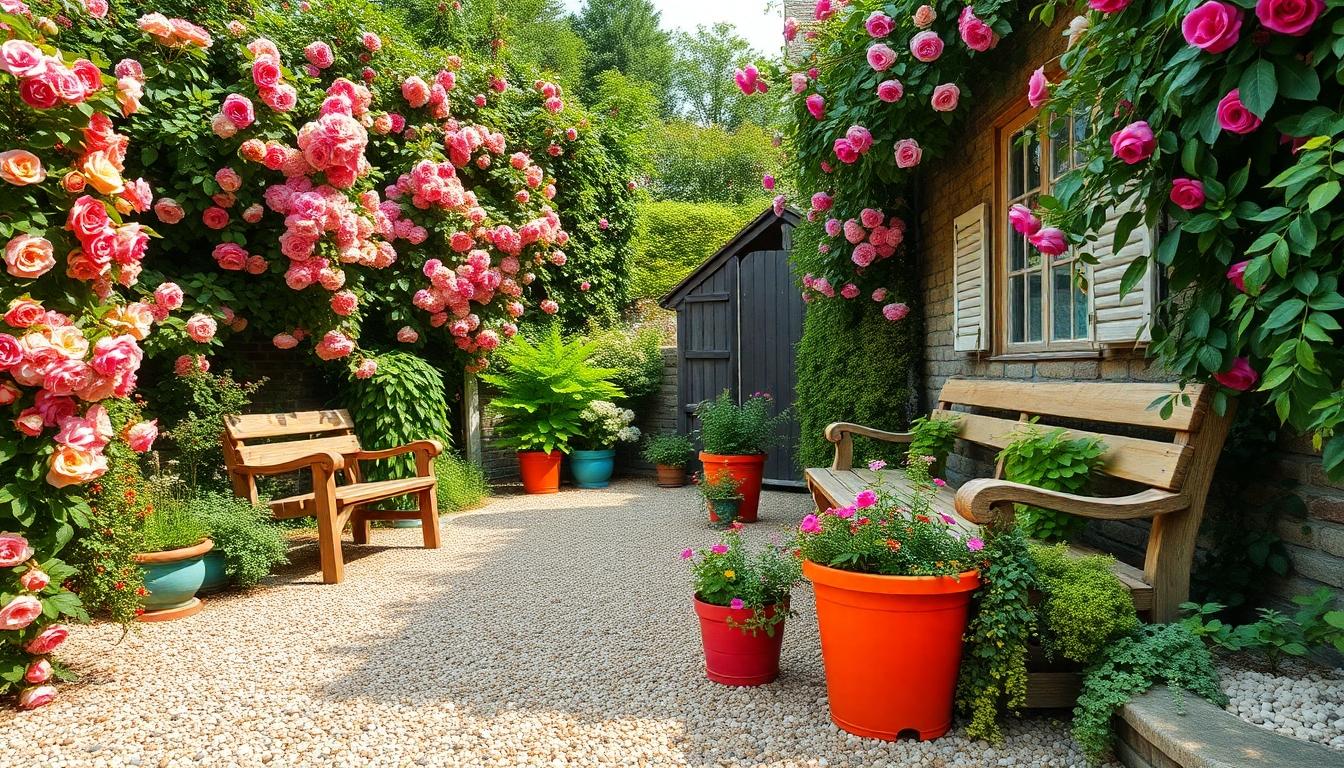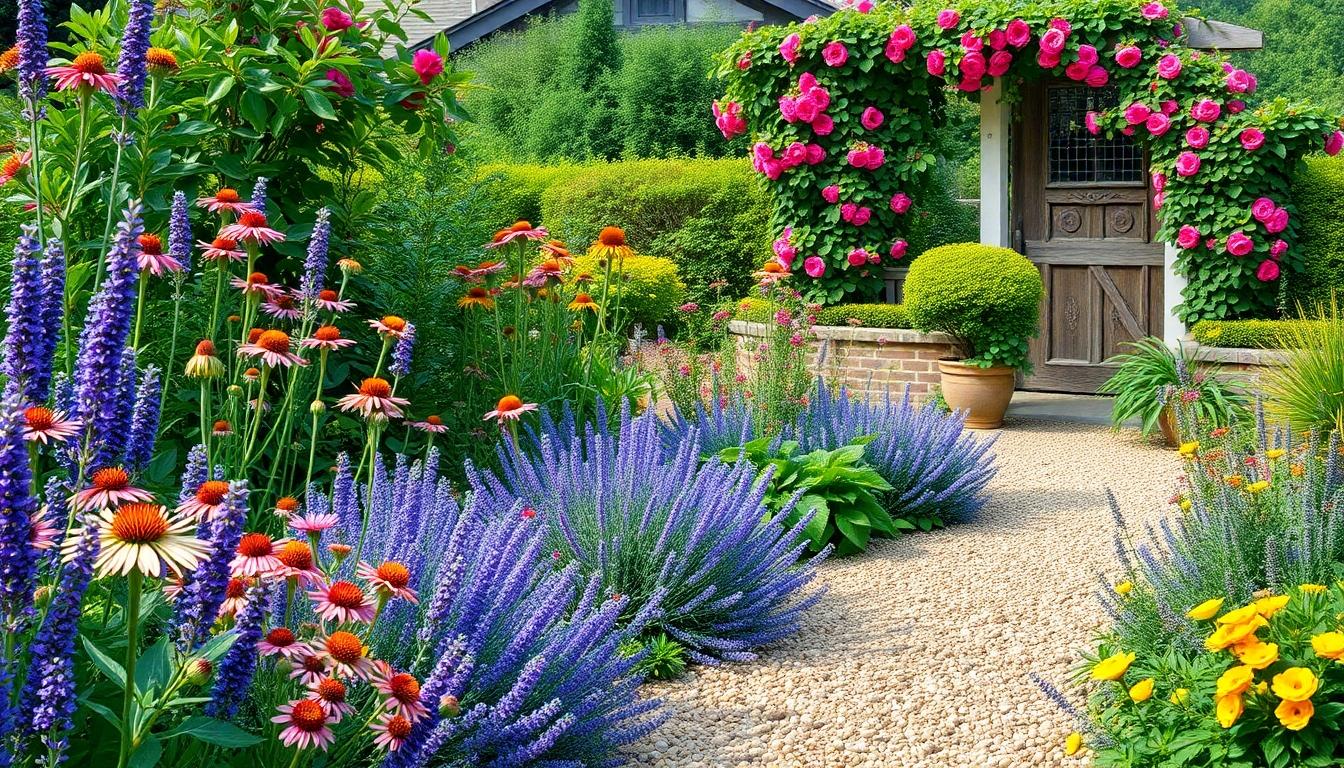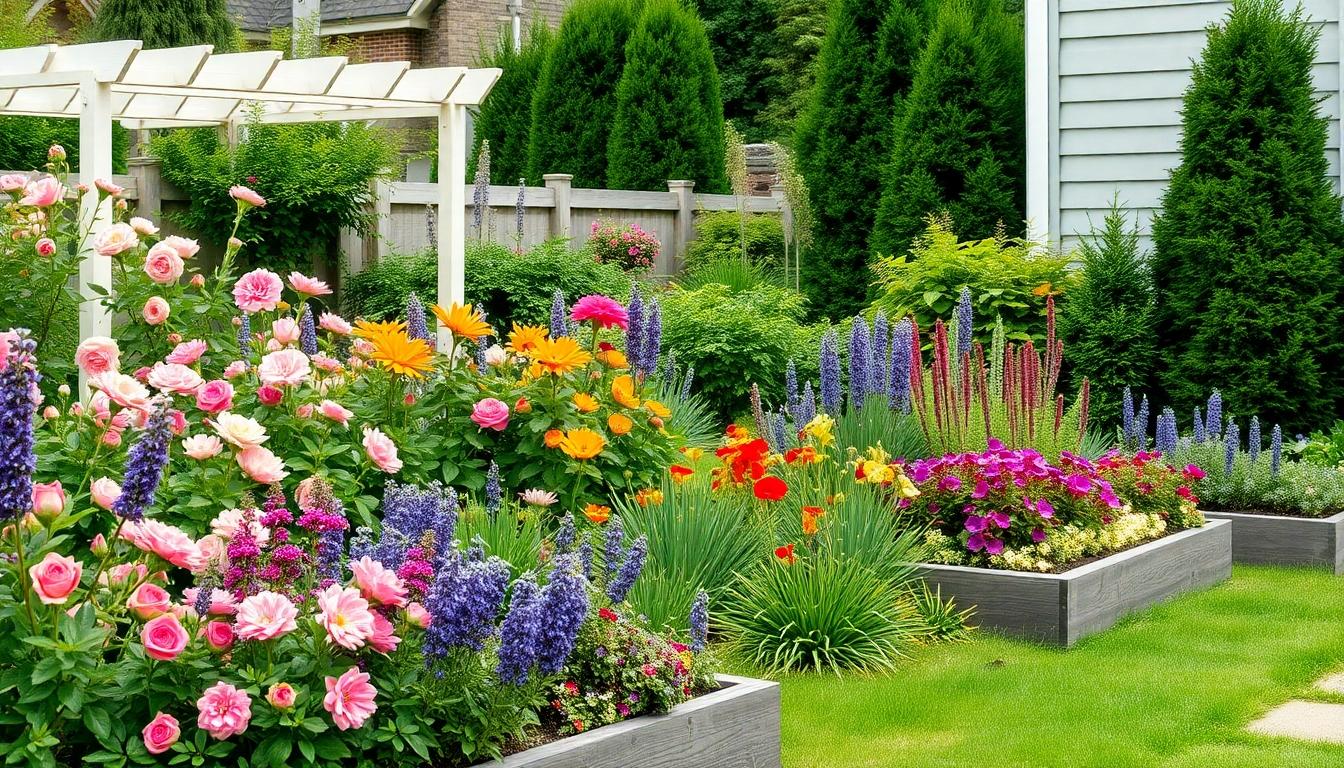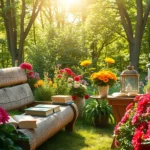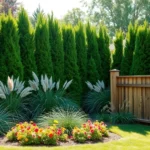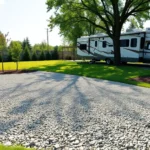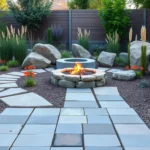Dreaming of a charming, flower-filled cottage garden that feels both whimsical and timeless? We’ve gathered the most enchanting cottage garden design ideas to transform your outdoor space into a picturesque retreat that bursts with color and character.
Whether you’re working with a sprawling country yard or a modest urban plot, the cottage garden style offers unparalleled versatility. These gardens blend informal planting schemes with traditional elements—creating spaces that feel perfectly imperfect. From climbing roses and hollyhocks to winding pathways and rustic accessories, we’ll guide you through creating your own cottage-inspired haven that blooms throughout the seasons.
10 Enchanting Cottage Garden Design Ideas for a Charming Outdoor Sanctuary
1. Create Meandering Pathways
Winding paths add whimsical charm to cottage gardens while providing practical access to plants. Natural materials like flagstone, gravel, or brick create authentic pathways that complement lush plantings. Allowing low-growing plants like creeping thyme or Roman chamomile to spill onto path edges softens the lines and creates that signature cottage garden look. Curved rather than straight paths encourage visitors to slow down and appreciate the garden’s beauty from different angles.
2. Embrace Abundant Perennial Plantings
Perennials form the backbone of any successful cottage garden with their reliable yearly returns. Classic choices include delphiniums, foxgloves, peonies, and hollyhocks that provide vertical interest and nostalgic appeal. Planting in drifts rather than single specimens creates the informal, abundant look that cottage gardens are known for. Mixing flower forms, heights, and blooming periods ensures your garden remains vibrant throughout growing seasons.
3. Add Climbing Plants and Vertical Elements
Vertical elements transform ordinary cottage gardens into enchanting retreats full of dimension. Climbing roses, clematis, and honeysuckle can be trained up trellises, arches, or fences to draw the eye upward. Obelisks and tuteurs placed throughout garden beds provide support for climbing plants while adding architectural interest. These vertical elements create magical tunnels and framed views that define garden rooms within your space.
4. Incorporate Charming Garden Structures
Structures like arbors, pergolas, and picket fences add instant cottage character while serving practical purposes. A weathered wooden bench tucked among flowers creates a perfect spot for quiet contemplation. Bird baths, sundials, and other ornamental elements contribute to the garden’s storybook appeal when thoughtfully placed. Even practical elements like tool sheds can become charming focal points when adorned with climbing roses or decorative details.
5. Mix Edibles with Ornamentals
Cottage gardens traditionally blended beauty with utility, making modern kitchen gardens their natural descendants. Herbs like lavender, sage, and rosemary offer aromatic foliage alongside their culinary uses. Vegetables like rainbow chard, purple cabbage, and climbing beans contribute interesting textures and colors to ornamental beds. Edible flowers such as nasturtiums, pansies, and borage fulfill both decorative and practical roles in the garden.
6. Layer Plants for Depth and Interest
Successful cottage gardens feature thoughtful layering with taller plants at the back, mid-sized specimens in the middle, and low-growing varieties at the front. This strategic arrangement ensures all plants receive adequate sunlight while creating a lush, abundant appearance. Plants with different flowering times should be intermixed so bare spots never appear as certain species finish blooming. Careful layering creates the impression of carefree abundance that actually requires thoughtful planning.
7. Use Self-Seeding Annuals for Spontaneity
Self-sowing annuals like poppies, nigella, and cosmos add delightful surprise elements to cottage gardens. These voluntary plants fill gaps naturally and create the slightly untamed look that defines cottage style. Their ability to pop up in unexpected places contributes to the garden’s evolving, organic feel year after year. We recommend deadheading some flowers while allowing others to set seed for controlled spontaneity.
8. Incorporate Romantic Roses
No cottage garden feels complete without roses, preferably varieties with nostalgic appeal and intoxicating fragrance. Old garden roses and modern shrub roses with informal growth habits work particularly well in cottage settings. David Austin English roses offer the perfect combination of old-fashioned appearance with improved disease resistance. Roses can serve as focal points, climbing specimens, or be integrated throughout the garden for romantic charm.
9. Add Whimsical Garden Accents
Personal touches transform ordinary gardens into unique, character-filled spaces that reflect your personality. Vintage finds like weathered watering cans, antique tools, or repurposed containers add nostalgic charm. Birdhouses, bee hotels, and butterfly pudding stations invite beneficial wildlife while adding decorative elements. These whimsical accents should feel naturally integrated rather than randomly scattered throughout the space.
10. Design for Four-Season Interest
Truly enchanting cottage gardens offer visual appeal beyond the summer flowering season. Spring-flowering bulbs like daffodils and tulips provide early color before perennials emerge. Evergreen structural elements like boxwood or herbs maintain winter interest when deciduous plants go dormant. Ornamental grasses, seed heads, and plants with colorful bark extend the garden’s beauty into fall and winter months. Planning for year-round interest ensures your cottage garden remains charming regardless of season.
Creating the Perfect Cottage Garden Layout
A well-designed cottage garden layout balances charming informality with thoughtful planning. Let’s explore the essential elements that will help you create that quintessential cottage garden feel in your outdoor space.
Curving Pathways and Informal Borders
Curving pathways serve as the backbone of any authentic cottage garden design, guiding visitors through your plant paradise with natural flow. We recommend using materials like bluestone, brick, wood chips, or gravel to create these winding routes that add warmth and invite exploration. The gentle curves create a sense of discovery as visitors move through the garden, revealing new plant combinations and garden features with each turn.
Informal borders complement these pathways by breaking away from strict geometric designs, instead embracing natural materials and irregular shapes. Your borders can feature a delightful mix of plants, including both ornamental blooms and edible varieties. This approach maintains the organic, unplanned appearance that’s central to cottage garden charm while still providing structure to your garden layout.
Layering Plants for Visual Interest
Plant layering creates depth and dimension in your cottage garden, making even small spaces feel lush and abundant. We suggest arranging plants from smallest to tallest, placing the shortest varieties along walkways and progressively adding medium and tall plants toward the outer edges. This strategic arrangement ensures every plant remains visible as you stroll through the garden.
Mixing different plant types creates the signature cottage garden tapestry effect. Combine classic flowers like roses and geraniums with aromatic herbs such as lavender and rosemary for a garden that engages all senses. The dense planting style characteristic of cottage gardens not only creates visual interest but also helps crowd out weeds naturally. For additional functionality, consider incorporating culinary herbs, medicinal plants, and pollinator-friendly varieties that attract bees and butterflies, adding biodiversity and ecological value to your garden.
Selecting Traditional Cottage Garden Plants
Traditional cottage gardens feature an enchanting mix of flowering perennials, herbs, and medicinal plants that create a lush, informal appearance while offering practical benefits. These plantings form the backbone of your cottage garden design, bringing color, fragrance, and a sense of nostalgia to your outdoor space.
Romantic Flowering Perennials
Roses stand as the quintessential cottage garden flower, providing old-industry charm and delightful fragrance throughout the growing season. Daisies offer simple beauty with their pristine white petals surrounding sunny yellow centers, creating a classic cottage garden look. Foxgloves contribute vertical interest with their tall spires of tubular blooms that attract beneficial pollinators to your garden space. Sweet peas deliver both incredible fragrance and delicate blossoms in various pastel shades, perfect for cutting gardens and adding height along fences or trellises. Lavender brings both visual appeal and aromatic benefits, with its purple-blue spikes adding texture and Mediterranean flair. Peonies create dramatic focal points with their lush, full blooms that return year after year, becoming more impressive with age and minimal care.
Aromatic Herbs and Medicinal Plants
Thyme creates an excellent ground cover in cottage gardens, releasing its distinctive scent when brushed against while providing culinary value throughout the growing season. Rosemary offers both vertical structure and aromatic foliage, thriving in sunny spots and adding Mediterranean character to your garden design. Chamomile produces delicate, daisy-like flowers that can be harvested for soothing teas, making it both ornamental and functional in your cottage planting scheme. Mint provides vigorous growth and refreshing fragrance, though it’s best contained in pots to prevent it from overwhelming neighboring plants. Traditional cottage gardens historically served practical purposes, with these aromatic herbs offering medicinal benefits alongside their ornamental qualities. Many of these herbs naturally repel certain garden pests while attracting beneficial insects, contributing to a balanced, ecological approach to garden management.
Incorporating Structural Elements into Your Cottage Garden
Structural elements add both charm and functionality to cottage gardens, creating a framework that enhances the natural beauty of your plantings. These architectural features help define spaces while adding vertical interest and traditional character.
Picket Fences and Garden Gates
Boundary elements like fences and gates serve as the perfect framework for your cottage garden, establishing its perimeter while adding considerable charm. White picket fencing represents the quintessential cottage garden boundary, creating an instantly recognizable pastoral aesthetic that frames your plantings beautifully. Alternative fencing options such as rustic wood, woven willow, or even well-maintained hedges can effectively define your garden’s edges while complementing its informal style. Garden gates function as inviting entry points that create anticipation and signal the transition into your special garden space. We recommend adorning these entryways with climbing roses or clematis to enhance their welcoming appeal and integrate them seamlessly with surrounding plantings. These boundary elements not only provide structure but also create a sense of enclosure that makes your garden feel like a private retreat from the outside industry.
Arbors and Trellises for Climbing Plants
Vertical structures dramatically enhance cottage gardens by adding height, dimension, and opportunities for climbing plants to flourish. Arbors and arches create charming thresholds between garden rooms while supporting magnificent climbing plants like wisteria, roses, or honeysuckle that cascade with flowers overhead. Trellises placed strategically throughout the garden provide essential support for vining plants while creating natural screens that offer privacy and define intimate seating areas. These vertical elements effectively draw the eye upward, adding crucial dimension to your garden and making even small spaces feel more expansive and layered. Placing a bench beneath an arbor draped with fragrant climbing roses creates a perfect spot for garden contemplation and enjoyment. Garden structures constructed from natural materials like weathered wood or wrought iron will develop character over time as they age alongside your plants, becoming integral components of your cottage garden’s unique personality.
Cottage Garden Container Ideas for Small Spaces
Limited space doesn’t mean sacrificing the charm of a cottage garden. Container gardening allows you to create that quintessential cottage feel even in the smallest areas, from balconies to tiny patios.
Window Boxes and Hanging Baskets
Window boxes offer an ideal solution for introducing cottage garden style to even the most space-challenged environments. These versatile containers instantly transform plain windowsills into flowering focal points that enhance your home’s exterior appeal. Trailing plants like lobelia, ivy, and nasturtiums create the characteristic cottage garden overflow effect when planted along the edges of window boxes. Combine these with upright blooms such as geraniums, sweet alyssum, and dwarf snapdragons for a layered, abundant look.
Hanging baskets function as aerial gardens that maximize vertical space while adding charm overhead. Position these flowering containers near entrances or along porches to create welcoming focal points. Ferns and trailing fuchsias thrive in partially shaded hanging positions, offering lush greenery and distinctive blooms. For sun-drenched areas, petunias, verbena, and million bells provide reliable color throughout the growing season. We recommend using coir-lined baskets which retain moisture better than standard plastic options and contribute to the rustic cottage aesthetic.
Repurposed Vintage Containers
Incorporating repurposed vintage items as planters adds authentic character to your small-space cottage garden. Old boots, ceramic crocks, galvanized washtubs, and weathered wooden crates all make excellent unconventional containers that tell a story. These unique vessels contribute to the informal, collected-over-time feeling that defines traditional cottage gardens.
Antique metal watering cans with drainage holes added to the bottom serve as charming homes for cascading herbs like thyme or oregano. Vintage wooden toolboxes accommodate multiple plant varieties in a single container, creating miniature cottage garden vignettes. Farm implements such as old wheelbarrows provide ample planting space while serving as standout garden features. For the best results, ensure all repurposed containers have adequate drainage and are proportionate to the plants they’ll hold. The patina and weathered quality of these items contribute significantly to the nostalgic cottage garden atmosphere, making them both functional and decorative elements in your small space design.
Adding Whimsical Cottage Garden Accents
Whimsical accents are the soul of cottage gardens, adding personality and charm to these informal landscapes. These decorative elements transform an ordinary garden into a magical retreat that reflects your unique style.
Bird Baths and Feeders
Bird baths serve as stunning focal points in cottage gardens while supporting local wildlife. Vintage stone birdbaths create an instant sense of timelessness when positioned among pollinator-friendly plants like lavender and coneflowers. We recommend placing these features where they’re visible from indoor living spaces so you can enjoy the visiting birds year-round. Hanging feeders attract diverse bird species, introducing movement and life to your garden’s atmosphere. For maximum impact, surround these features with plants that offer natural food sources, creating a sustainable habitat that enhances your garden’s ecological value.
Garden Art and Found Objects
Repurposed antiques breathe character into cottage gardens through their weathered patinas and nostalgic appeal. Old farm tools, weathered wooden chairs, or salvaged gates transform into conversation-starting garden art when thoughtfully incorporated among plantings. Mosaic stepping stones add splashes of color along pathways while hand-painted signs introduce whimsy and guidance through the garden. Creative gardeners often convert unexpected items like vintage teapots, rusty wagon wheels, or chipped enamelware into unique planters that tell stories. These salvaged treasures add layers of history and quirky charm that mass-produced decorations simply cannot match. Try nestling these found objects among billowing perennials for a discovered-not-decorated aesthetic that epitomizes cottage garden style.
Designing a Cottage Garden for Year-Round Interest
A truly magnificent cottage garden doesn’t disappear when summer fades—it transforms through the seasons, offering beauty in every month of the year. Creating this perpetual interest requires thoughtful planning and strategic plant selection.
Spring and Summer Blooms
Creating a vibrant cottage garden during the growing season means embracing diversity and abundance in your planting scheme. We recommend combining a rich tapestry of perennials and annuals such as roses, hydrangeas, and seasonal vegetables alongside cut flowers like cosmos and zinnias for continuous waves of color. Dense, curving beds filled with both ornamental and edible plants perfectly capture the essence of traditional cottage gardens while ensuring something is always blooming. Flowering shrubs, including weigela and camellias, provide rotating color throughout the warmer months without requiring replanting. Annual flowers certainly add vibrancy to any garden space, but focusing primarily on perennials will significantly reduce your maintenance workload while still delivering spectacular seasonal displays.
Fall and Winter Structure
Maintaining visual interest during dormant months depends on incorporating plants with strong structural elements and winter appeal. Evergreen shrubs such as boxwoods and dwarf conifers form the backbone of winter gardens, providing reliable greenery when deciduous plants have shed their leaves. Pairing these structural elements with ornamental grasses or groundcover roses adds essential texture and dimension to winter landscapes. Plants with distinct winter interest—including ornamental grasses with striking seed heads and shrubs that produce colorful berries—keep the garden captivating even in the coldest months. Allowing informal growth to slightly spill over pathways creates a natural, lived-in aesthetic that preserves the cottage garden charm year-round. Curved pathways and beds enhance visual depth throughout all seasons, while layered planting arrangements—with taller shrubs in back, mid-height perennials in the middle, and low-growing plants in front—ensure the garden maintains its dimensional quality regardless of the season.
Creating Cottage Garden Rooms and Destinations
A well-designed cottage garden invites exploration and creates distinct spaces for relaxation and enjoyment. By thoughtfully arranging plantings and hardscape elements, you can transform your garden into a series of enchanting destinations.
Defining Garden Rooms
Garden rooms offer intimate spaces within your cottage industry, creating a sense of discovery as you move through the garden. Curved pathways made from gravel, stepping stones, or brick guide visitors naturally between different areas while maintaining the informal cottage aesthetic. Dense plantings serve as living walls, with raised beds and climbing plants like roses and clematis creating vertical definition and adding layers of interest. Privacy screens formed by shrubs or decorative lattice help separate spaces while maintaining the garden’s cohesive flow. Adding fragrant plants such as lavender and jasmine enhances the sensory experience, while incorporating wildflower meadows creates transition zones between more structured areas.
Seating Areas and Garden Benches
Rustic benches strategically positioned throughout your cottage garden create inviting spots to pause and appreciate the surrounding beauty. Place vintage furniture or weathered wooden seating in shaded locations or near eye-catching focal points like water features or flowering arbors. Picket fences and informal hedges can frame these seating areas, creating a sense of enclosure and intimacy. Containers filled with trailing flowers such as petunias and lobelia placed around seating areas add layers of color and texture at different heights. Consider positioning benches where they capture pleasant garden views or fragrant plantings, allowing visitors to fully immerse themselves in the garden experience.
Secret Garden Nooks
Secret nooks tucked away within your cottage garden create magical destinations that reward exploration. Arched pathways covered with overhead greenery like wisteria or honeysuckle form natural entrances to these hidden retreats. Blurred boundaries created by billowing plants such as hollyhocks and delphiniums enhance the sense of seclusion and discovery. Hidden seating nestled beneath climbing roses or behind ornamental grasses offers private spots for reflection or intimate conversations. These secluded spaces feel especially enchanting when designed with a distinct character that differs slightly from the main garden areas, perhaps through a focused color scheme or special plant collection that creates a sense of having entered a different industry.
Key Elements for All Garden Destinations
Successful cottage garden rooms incorporate traditional elements that enhance their charm and functionality. Heirloom plant varieties like peonies and foxgloves lend authenticity, while edible plants including herbs and strawberries add practical value to ornamental spaces. Color palettes featuring soft pinks, mauves, and whites create a romantic atmosphere, with occasional pops of purple or blue adding visual interest and depth. These thoughtful combinations of plants, materials, and design principles help create distinctive garden rooms that retain the informal, abundant character that makes cottage gardens so beloved.
Low-Maintenance Cottage Garden Approaches
Creating a beautiful cottage garden doesn’t have to mean endless hours of work. We’ve gathered practical approaches to help you design a charming space that requires less maintenance while still capturing that quintessential cottage garden feel.
Start Small and Manageable
- Begin with defined sections rather than tackling your entire yard at once. This strategy prevents overwhelm and allows you to perfect small areas before expanding.
- Install smart irrigation systems like drip lines or mini sprinklers that target water directly to plant roots. These systems dramatically reduce manual watering time while improving plant health.
- Choose hardy perennials as the backbone of your garden. Plants like lavender, coneflower, and other resilient varieties require minimal intervention once established.
- Incorporate self-seeding annuals such as cosmos and poppies that naturally propagate, eliminating the need for annual replanting.
- Plant in clusters or drifts instead of scattered individuals. This approach creates visual cohesion while making maintenance tasks like weeding and pruning more efficient.
Sustainable Planting Techniques
- Prioritize native plant species that have naturally adapted to your local conditions. These plants typically require less water, fertilizer, and overall care while supporting local pollinators and wildlife.
- Enhance soil quality with compost and organic mulches like fish mulch. Healthy soil retains moisture better, reduces weed growth, and supports stronger plants that resist disease.
- Mix edibles with ornamentals throughout your garden beds. Herbs like thyme and rosemary offer both culinary benefits and attractive foliage, while many vegetables can serve as decorative elements.
- Create plant communities that work together naturally, mimicking how plants grow in the wild. Plants with similar needs grouped together simplify care routines.
- Reduce lawn areas gradually by expanding garden beds, decreasing the time spent on mowing and lawn maintenance.
Time-Saving Design Strategies
- Use vertical growing space with trellises, arbors, and wall-mounted planters. Climbing roses and clematis add dramatic height while requiring less ground maintenance than sprawling varieties.
- Repeat plant varieties throughout the garden to create visual rhythm and simplify your plant palette. This approach reduces decision fatigue when selecting and caring for plants.
- Replace traditional lawns with densely planted beds that achieve the classic abundant cottage look without weekly mowing. Ground covers can fill spaces between larger specimens.
- Limit pathways to essential routes through the garden, using low-maintenance materials like gravel or stepping stones. These materials allow rainwater to permeate while discouraging weed growth.
- Choose plants with multiple seasons of interest, reducing the need to replant for different times of year. Look for varieties that offer attractive foliage, flowers, seed heads, and winter structure.
Modern Twists on Traditional Cottage Garden Design
Today’s cottage gardens blend timeless charm with contemporary elements, creating spaces that honor tradition while embracing modern sensibilities. Contemporary designs incorporate structured elements like raised beds to organize plantings within the characteristic informal layout. Following the “70/30 rule” offers a perfect balance—maintain 70% traditional cottage plants while introducing 30% modern hardscaping or drought-tolerant species for a fresh aesthetic. Vertical elements add architectural interest through sleek trellises and overhead arbors adorned with flowering vines, bringing dimension and drama to the garden space.
Contemporary Color Schemes
Modern cottage gardens expand beyond traditional color palettes to create striking visual statements. While classic designs favor soft pinks, gentle mauves, and pristine whites, contemporary approaches embrace bold monochromatic schemes for dramatic impact. Contrasting color combinations, such as deep-red roses paired with lavender geraniums, create eye-catching focal points throughout the garden. Neutral backdrops using evergreen shrubs provide the perfect canvas for vibrant blooms to shine. Gray-foliage plants like lamb’s ear offer sophisticated contrast against colorful perennials while maintaining the cottage garden’s relaxed atmosphere. These thoughtful color strategies allow for personal expression while preserving the quintessential cottage garden charm.
Eco-Friendly Cottage Garden Practices
Sustainable techniques transform traditional cottage gardens into environmental havens without sacrificing beauty. Dense plantings of native perennials and groundcovers effectively replace water-hungry lawns while naturally suppressing weeds and retaining soil moisture. Pollinator-friendly species such as lavender and coneflowers support local ecosystems and bring gardens to life with beneficial insects. Gravel or wood-chip pathways edged with reclaimed materials reduce water runoff while improving drainage throughout the garden. Compost-rich soil amendments nourish plants naturally, eliminating the need for synthetic fertilizers. Drought-resistant varieties like geranium ‘Rozanne’ minimize water requirements while providing long-lasting color. These eco-conscious approaches honor the self-sufficient spirit of traditional cottage gardens while addressing modern environmental concerns.
Bringing Your Cottage Garden Design to Life
Creating your dream cottage garden is both an art and a journey. With the right mix of meandering pathways curved flowers and thoughtful accessories you’ll cultivate not just a garden but a personal sanctuary.
Whether you’ve embraced traditional elements or added modern twists remember that cottage gardens evolve with time. The magic happens when your garden reflects your personality while honoring timeless design principles.
Start small experiment often and allow your garden to develop its unique character. By balancing structure with spontaneity and practicality with whimsy you’ll create an enchanting outdoor space that delights through every season.
Now it’s time to get your hands dirty and watch your cottage garden bloom into the charming retreat you’ve always envisioned.
Frequently Asked Questions
What is a cottage garden?
A cottage garden is an informal, charming garden style characterized by dense, abundant plantings of flowers, herbs, and edibles in a seemingly casual arrangement. It originated from traditional English country gardens and emphasizes a natural, romantic aesthetic with meandering pathways, climbing plants, and whimsical elements that create a sense of nostalgic charm and year-round interest.
Can I create a cottage garden in a small space?
Absolutely! Cottage gardens are highly adaptable to small spaces. Utilize container gardening with window boxes, hanging baskets, and repurposed vintage containers. Incorporate vertical elements like trellises to maximize growing space. Focus on layered plantings and select compact varieties of traditional cottage plants. Even a balcony or tiny urban yard can capture the essence of cottage garden charm.
What are the best plants for a cottage garden?
Traditional cottage garden plants include romantic flowering perennials like roses, foxgloves, daisies, lavender, and peonies. Include aromatic herbs such as thyme, rosemary, and mint for both beauty and function. Incorporate self-seeding annuals like poppies and cornflowers for spontaneous charm. Climbing plants like clematis and honeysuckle add vertical interest. Choose a mix that offers continuous blooming throughout growing seasons.
How do I create pathways in a cottage garden?
Create meandering, rather than straight pathways using natural materials like bluestone, gravel, brick, or stepping stones. Design paths to curve gently through garden areas, creating a sense of journey and discovery. Allow plants to spill slightly onto the edges for a soft, informal look. Ensure paths are wide enough for comfortable walking while maintaining the intimate cottage garden feel.
Do cottage gardens require a lot of maintenance?
Not necessarily. While traditional cottage gardens can be labor-intensive, modern approaches offer lower-maintenance options. Start small, install efficient irrigation, and choose hardy perennials as the backbone. Incorporate self-seeding annuals and plant in clusters for easier care. Prioritize native species adapted to your climate and build healthy soil with compost. These strategies create beautiful cottage gardens with significantly reduced upkeep.
How can I add structure to my cottage garden?
Add structure with both plants and hardscape elements. Install vertical features like arbors, trellises, and obelisks to support climbing plants. Include boundary elements such as picket fences or low stone walls to define the space. Incorporate evergreen shrubs and ornamental grasses for year-round framework. Create “garden rooms” with strategic plantings and pathways. These elements provide essential architecture while maintaining cottage charm.
Can cottage gardens work in modern landscapes?
Yes! Modern cottage gardens blend traditional charm with contemporary sensibilities. Follow the “70/30 rule” by pairing 70% traditional cottage plants with 30% modern hardscaping elements. Experiment with bold color combinations beyond classic palettes. Incorporate eco-friendly practices like rainwater harvesting and native plantings. Add structured elements like raised beds for a cleaner look while preserving the lush, abundant planting style characteristic of cottage gardens.
How do I create year-round interest in a cottage garden?
Plan for continuous seasonal appeal by selecting plants with varied blooming times. Include spring bulbs, summer perennials, fall-flowering plants, and winter-interest species like ornamental grasses and evergreens. Incorporate structural elements that look attractive year-round. Add plants with interesting seed heads, bark, or persistent berries for winter interest. Consider four-season hardscape features like decorative containers, garden art, and seating areas.
What accessories enhance a cottage garden’s charm?
Incorporate whimsical elements like bird baths, feeders, and decorative garden art. Repurposed vintage items such as old watering cans, wheelbarrows, or ceramic containers add nostalgic character. Install comfortable seating areas using rustic benches or vintage furniture to create inviting spots to enjoy the garden. Decorative structures like arbors and gates adorned with climbing plants serve as both functional and ornamental features.
How do I mix edibles and ornamentals in a cottage garden?
Interplant vegetables, herbs, and fruits among ornamental flowers following the traditional cottage garden philosophy. Choose attractive edibles like rainbow chard, purple cabbage, and flowering herbs. Plant edibles in decorative patterns rather than rigid rows. Incorporate fruit trees or bushes as anchor plants. Use attractive supports for climbing edibles like beans and peas. This integrated approach provides both beauty and bounty while honoring cottage garden traditions.

